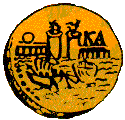
Reinhardt, E.G., Patterson, R.T., and Schroder-Adams, C.J., 1994, Geoarchaeology of the ancient harbor site of Caesarea Maritima, Israel: Evidence from Sedimentology and Paleoecology of Benthic Foraminifera: Journal of Foraminiferal Research, v.24, no 1, p. 1-12.
Foraminiferal analysis and 14C dating of a core obtained from the entrance of the ancient harbor site of Caesarea Maritima, Israel provided paleo-environmental information which has enhanced previous archaeological interpretations. This integrated micropaleontological - sedimentological approach presents a new tool for solving marine archaeological problems.
Four distinct sedimentological units related to the harbors history were recognized: preharbor deposits, harbor construction rubble, harbor and post harbor deposits (Stratigraphic Section). The sediments from the active harbor are characterized by sedimentation of mud, interrupted by intervals of coarse sand deposited during large low periodicity (25-50 years) storms. The area outside the harbor moles was continuously under the influence of wave action resulting in deposition of a coarse sandy substrate.
The sediment distribution corresponds with two distinct foraminiferal assemblages: Biofacies 1 is related to a low energy muddy substrate and is characterized by Ammonia tepida, Cornuspira foliacea, Haynesina depressula and Triloculina subgranulata; Biofacies 2 is related to a high energy sand substrate and is characterized by Ammonia parkinsoniana and Porosononion granosum. There is an inverse relationship along the Ammonia tepida - Ammonia parkinsoniana ecophenotypic cline, relative to the water energy of the two environments.
Sedimentological and foraminiferal evidence as well as 14C dates indicate that the mud was from the active harbor (commissioned in 21 BC) and that the harbor was no longer functioning according to its original design probably by the mid third century and definitely by no later than 490 AD. Previous research has suggested that the degradation of the harbor was most likely related to the tectonic movement of the area. However, the timing of this event was not exactly known. Archaeologists have speculated that the Byzantine Emperor Anastasius I refurbished the harbor in the early 6th century. The results of this study indicate that, even if this reconstruction did occur, the harbor was not returned to its original design or function.